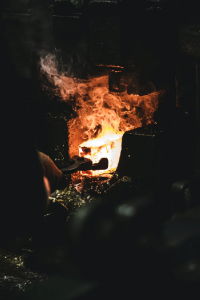History of Forging
Forging is the process of shaping metal using force and is one of the oldest techniques in human history, it has created new tools still used today as well as many archaic weapons. The prolific art of forging dates back to at least 4000 BC, mainly using materials such as bronze, iron, and for those in higher status positions gold. All these materials were forged using hand tools until the mid-19th Century when the invention of the steam engine changed forging drastically. Although smiths worked with many materials for practical uses, wrought iron was used for decorative purposes, meaning smiths became very skilled in hammer-wielding as well as with using engines.
Of course, during the industrial revolution forging took a whole new form. During this time better equipment was developed meaning hammer-wielding was now purely mechanical and used a variety of motors from steam to electric. This process is still used today but using much better mechanisms and power supplies.
Forging Today
Forging is a huge industry today and has stood the test of time. Although the process is the same at its core as it was historically, we now have computer-controlled hydraulics and machinery to do the forging, although the historic processes are still used for certain industries. Forging can be split into two main sections, hot forging, and cold forging.
Cold forging is most commonly used on carbon alloy steels using a closed-die process and doesn’t work on all materials. This type of forging deforms metal while it is below its recrystallization point and increases its strength drastically. In contrast, iron and steel are commonly hot forged using intense heat up to 800 °c. This heat means the material is malleable and can be pressed and hammered into different shapes. There are a lot of benefits to hot forging, including increased ductility for components such as computer and machinery parts.
Modern forging provides the world with tools for all industries from automotive to aerospace. These are generally created by placing stress on steel billets, using a variety of open die forging and closed die forging. This means that manufacturers are not limited to small shapes.
